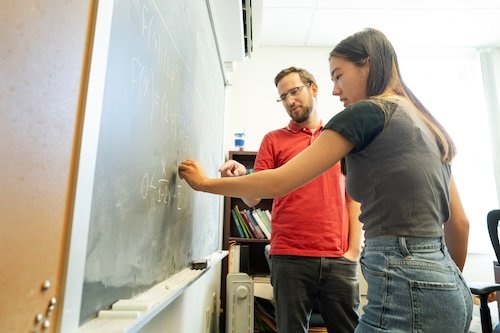Imagine you are an art collector and you want to expand your collection. Your long-term goals are two-fold. It’s about optimizing the monetary value of your collection while maintaining a beautiful collection at the same time.
How do you balance two conflicting goals?
Audrey Benson ’25 wants to solve this problem.
Audrey Benson ’25 is working with Assistant Professor of Mathematics Fanuel Mariano to research mathematical models for art collectors. She will present her research at the Joint Mathematics Conference, the world’s largest gathering of mathematics enthusiasts and professionals, in Seattle in January.
Benson is working with assistant professor of mathematics Fanuel Mariano to research mathematical models that could change the world of collecting.
Guided by a series of complex and random matrices, Benson’s research has practical applications not only in the burgeoning world of art collectors, but also for those who collect assets for both financial and emotional purposes. It may be possible. This could include cars, wine, coins, etc.
Previous research has shown that one in three Americans may collect something.
“It was very exciting,” said Benson, a math major from Poughkeepsie, New York. “I’ve worked on other projects before, but this is the first time I’ve done it myself.”
Benson’s project began last summer as part of a National Science Foundation grant awarded to Mariano. The student and professor wanted to build on recent research that developed a mathematical model for art collectors.
The model relies heavily on principles and concepts familiar to mathematicians, such as Bernoulli random variables, Lyapunov exponents, and the Fibonacci sequence.
The exponential growth rate of an asset’s long-term value is known as the Lyapunov index. The higher this number, the more assets you have. In most situations, calculating this index is difficult, if not impossible, according to Mariano. Benson’s project includes a new way to calculate exponents using a surprising connection to the Fibonacci sequence, where each term is equal to the sum of the two preceding elements.
Did you understand?
“It’s all one big puzzle,” said Mariano, who is in his fifth year at Union. “We are trying to solve the puzzle step by step.”
The two meet twice a week to review Benson’s research.
“We get along really well,” Benson said. “I took a probability class with him, and I understood the way he explained things.”
Benson didn’t always like numbers. She hated math in high school. She planned to major in English when she came to Union. But after taking some math courses and getting good grades, she was sold.
“I feel like everyone was taught to hate math growing up,” Benson said. “When you sit down and realize that math is like a puzzle, you appreciate it even more.”
Hands-on research helped Benson develop other skills, such as coding.
“I’m learning so much more than just math,” she said.
Mariano appreciates the opportunity to work with students like Benson. Faculty-led undergraduate research is a pillar of Union’s curriculum.
“If I were teaching at a large research university, it would be difficult to work one-on-one with undergraduates,” he says. “It’s great to be in a place like Union, where you have the opportunity to find motivated students like Audrey and be able to support them.”
Benson will present his research at the Joint Mathematics Conference, the world’s largest gathering of mathematics enthusiasts and professionals, in Seattle in January. Mariano will also be there.
The two hope to eventually publish their research in a mathematics journal.
Benson plans to attend graduate school and eventually earn a Ph.D. In statistics.
All of this is crazy for a student who planned to major in English but now considers himself a math geek.
“It’s not that you don’t like math,” Benson said of the subject, which suffers from a bad reputation. “You and math can actually work together.”

